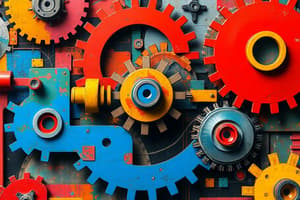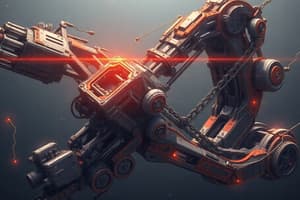Podcast
Questions and Answers
Which of the following is the definition of a machine element?
Which of the following is the definition of a machine element?
- The portion of a machine that transfers motion and forces from a power source to the output
- A structure capable of transmitting forces without relative motion
- A piece of a mechanism that causes motion
- A mechanical combination of fixed or flexible parts (correct)
What is the difference between pure mechanism and constructive mechanism?
What is the difference between pure mechanism and constructive mechanism?
- Pure mechanism deals with the motion and forms of machine parts, while constructive mechanism involves calculating the forces acting on different parts of a machine (correct)
- Pure mechanism involves calculating the forces acting on different parts of a machine, while constructive mechanism deals with the motion and forms of machine parts
- Pure mechanism is the portion of a machine that transfers motion and forces from a power source to the output, while constructive mechanism deals with the motion and forms of machine parts
- Pure mechanism and constructive mechanism are the same thing.
What are kinematic pairs?
What are kinematic pairs?
- A combination of resistant bodies that produce work with certain determined motions
- Pieces of a mechanism that cause motion
- Two links or elements of a machine that, when in contact with each other, form a pair with completely or successfully constrained relative motion between them (correct)
- A structure that supports the moving parts and regulates their path
Which type of link has varying degrees of deformation?
Which type of link has varying degrees of deformation?
What is the difference between a mechanism and a structure?
What is the difference between a mechanism and a structure?
What are drivers and followers in a mechanism?
What are drivers and followers in a mechanism?
Flashcards are hidden until you start studying
Study Notes
Introduction to Machine Elements and Kinematic Pairs
- A machine element is a mechanical combination of fixed or flexible parts.
- Pure mechanism deals with the motion and forms of machine parts, while constructive mechanism involves calculating the forces acting on different parts of a machine.
- A machine is a combination of resistant bodies that produce work with certain determined motions.
- A structure is a combination of resistant bodies capable of transmitting forces or carrying loads without relative motion between parts.
- A mechanism is the mechanical portion of a machine that transfers motion and forces from a power source to the output.
- A frame is a structure that supports the moving parts and regulates their path.
- A particle is an infinitesimal part of a body, often referred to as a point or a series of contiguous particles arranged in a line.
- A rigid body is a compound particle that remains at a constant distance from one another.
- Drivers are pieces of a mechanism that cause motion, while followers are pieces that follow the motion of the driver either clockwise or counterclockwise.
- Modes of transmission include links, bands, and bearings, each with specific characteristics for transmitting motion.
- Different types of links include rigid, flexible, and fluid links, each with varying degrees of deformation.
- Kinematic pairs are two links or elements of a machine that, when in contact with each other, form a pair with completely or successfully constrained relative motion between them. Different types of kinematic pairs include sliding, turning, rolling, screw, spherical, lower, and higher pairs.
Introduction to Machine Elements and Kinematic Pairs
- A machine element is a mechanical combination of fixed or flexible parts.
- Pure mechanism deals with the motion and forms of machine parts, while constructive mechanism involves calculating the forces acting on different parts of a machine.
- A machine is a combination of resistant bodies that produce work with certain determined motions.
- A structure is a combination of resistant bodies capable of transmitting forces or carrying loads without relative motion between parts.
- A mechanism is the mechanical portion of a machine that transfers motion and forces from a power source to the output.
- A frame is a structure that supports the moving parts and regulates their path.
- A particle is an infinitesimal part of a body, often referred to as a point or a series of contiguous particles arranged in a line.
- A rigid body is a compound particle that remains at a constant distance from one another.
- Drivers are pieces of a mechanism that cause motion, while followers are pieces that follow the motion of the driver either clockwise or counterclockwise.
- Modes of transmission include links, bands, and bearings, each with specific characteristics for transmitting motion.
- Different types of links include rigid, flexible, and fluid links, each with varying degrees of deformation.
- Kinematic pairs are two links or elements of a machine that, when in contact with each other, form a pair with completely or successfully constrained relative motion between them. Different types of kinematic pairs include sliding, turning, rolling, screw, spherical, lower, and higher pairs.
Studying That Suits You
Use AI to generate personalized quizzes and flashcards to suit your learning preferences.




